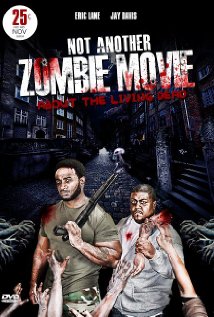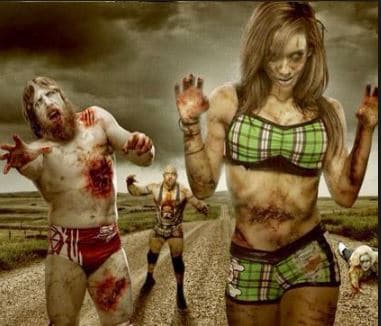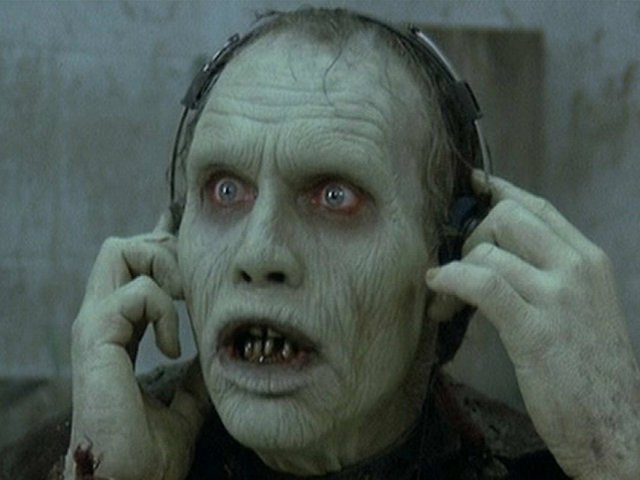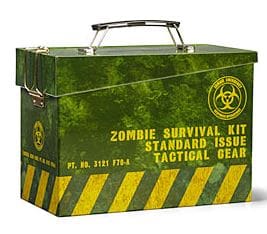Well, yes. Hallowe’en demands attention to the growing, under-served, ever-changing Zombie market for hearing healthcare. Past posts uncovered the market and provided pointers to Audiologists on how to capitalize on it.
Today’s post pulls together zombie odds and ends in hopes of extending market reach and protecting Audiologists’ newly dug-up turf from other less-qualified biomedical professionals. Here are suggestions and ideas to help audiology practices gain a better understanding of zombies’ hearing care needs by offering basic, specialty, and secondary services; expanding sales of hearing aids; and developing the market for hearing care accessories.
Target Your Market
The first thing is to find the zombies and get a handle on their lifestyles. Many itinerant bunches are swarming party animals, restlessly searching for brains and ocean front properties. Expect noise-induced hearing loss in these folks.
Others are burrowing homebodies, living quietly underground in snow-covered boroughs, cemeteries, and other quiet neighborhoods near you. Though they’ve avoided noise by laying low, they cannot escape sensorineural hearing loss resulting from auditory neuropathy. Likewise, the new improved walking dead, more politically correctly referred to as “survivors of Partially Deceased Syndrome (PDS)” are living (sort of) among us, but without restored hearing. More than most, those with PDS are desperate to fit in and are especially open to hearing correction.
Whatever their lifestyles, zombies of all types pose an elusive market to target. But there’s a map for that. Smart audiologists will use it to see Opportunity where others see only Threat.
Zombie Safe Zone Maps let you think outside the box, find the zombies, and create previously-unimaginable marketing opportunities. The maps point you to the most popular cities for zombies while doing double duty by recommending escape routes to non-zombies, including your competitors. Advertising just got easier, too. Larson Electronics offers a host of high-intensity signal devices to beckon the walking dead, with the added attraction that you can see them coming with enough advance notice to prepare the office and greet them properly (see below).
Use your brains (before the zombies get them): when global economies collapse with the zombie apocalypse, you’ll be the only game in town. You’ll have full access to the entire (remaining) population, all zombies sharing the same needs and wants, and the wherewithal to afford it. Most zombies come from formerly successful careers as humans with bank accounts, retirement investments, financial advisers, and trustees.
Here’s some insider information for your long-term marketing plan: consider relocating or opening a branch office in Alaska, the state most likely to weather a zombie apocalypse.
Know Their Needs and Wants
Need #1: Speech and language therapy. The most important need zombies have is for good communication. Neuroscientists Verstnen and Voytek (2014){{1}}[[1]]Verstnen T & Voytek B. Do zombies dream of undead sheep? A neuroscientific view of the zombie brain. Princeton: Princeton Univ Press (2014).[[1]] make the obvious point that “zombies aren’t particularly good at language.” In fact, their only communicative utterance is the “dreaded” zombie moan, a non-linguistic but “critical feature of the swarm intelligence.” The smart Audiologist will quickly seize on their need for language therapy by adding speech pathology to the practice’s offerings.
Need #2: Audiometric verification of hearing thresholds. Verstnen and Voytek jump the shark and their scope of practice by equating hearing a moan to normal hearing thresholds.{{2}}[[2]]Do not look to this book for solid hearing facts. Actually, don’t buy it at all. For example, the authors claim that the ABR was invented by Galambos, which probably makes Jewett and Williston turn over in their graves if not rise up from them.[[2]] Wild statements like that coming out of Princeton Press make it clear why the hearing health community must protect the profession through regulation, licensure, AuDs, and militant membership organizations. Zombies are the least of our worries.
All Audiologists worth their salt recognize the moan theory as a new version of the old SDT/SRT argument writ large. It lends zero support to the neuroscientists’ dubious conclusion that “…zombies process sounds in their ears with sensitivity that is probably as good as, if not better than, that of a normal human brain.”
I think not. Hearing detection of a low-frequency, uncalibrated non-verbal utterances produced by unmonitored live voice is not a test of hearing, much less central auditory function. Notwithstanding their demonstrated response to low-frequency stimuli in the field, Hearing Economics continues to assert that significant bilateral, sloping, sensorineural hearing loss is the unrecognized and untreated norm for zombies.
What zombies, neuroscientists, and audiologists need is good audiometric and epidemiological data on swarms of zombies from all walks of unlife. And watch out for those false positives: detection of malingering is critical in zombie wannabes who may fake hearing loss as part of their cover. Audiologists are the only professionals who are licensed and trained to do this work with the accuracy and precision necessary to develop solid data that can help zombies and the hearing healthcare profession. We have a duty to provide it. Our membership organizations have a duty to develop Zombie Audiology Specialty Board Certification (ZASC) immediately. Get your ZASC, post it in your waiting room, an make your dues count.
Outfitting the office for zombie care has been covered in past posts. Today we have only to illustrate proper placement of earphones. It’s a good idea to let zombies position the phones themselves (Fig 2). Also, practitioners are reminded to observe good hygiene and rigorous infection control protocols as standard office protocols.
Need #3: Advanced hearing aid technology. Audiologists know recruitment when they see it. Hearing aid manufacturers use compression of every type to grapple recruitment to the ground. No doubt, zombies recruit. Those hapless neuroscientists document the phenomenon without recognizing it for what it is: abnormally large loudness at elevated threshold due to cochlear impairment:
“….in many cases… particularly loud or high-pitched sounds drive zombies into a frenzy, as if the sounds are painful to their ears and must be stopped at all costs. This means that while zombies can still hear perfectly well, they probably can’t easily focus their attention in a noisy environment.”
Wrong on all counts. Yes, loud sounds drive them to a frenzy. No, that doesn’t mean they hear perfectly well. Yes, they can’t attend in a noisy environment. No, that’s not because they hear so well; it’s because they hear so badly at the frequencies that count.
Zombies don’t need ear protection, they need fully-automatic, directional, wide dynamic range compression hearing aids with frequency lowering and wind noise reduction circuits dialed in to the max. And they need those instruments now, fitted by trained professionals.
Need #4: Comprehensive Hearing Aid Fitting Solutions: Past posts emphasized deep canal fittings as standard for the many cartilage-challenged zombies roaming around. Other little-known niche zombie groups have specialty requirements. Chief among them are water-proof instruments for zombies who prefer scuba diving to beach parties. Water zombies (Fig 3) need the right hearing aids as well as the right goggles.
Need #5: Individualized, flexible service and product delivery. Zombies have trouble keeping office appointments. By all appearances, they do not wear watches, carry Smartphones, or drive cars. Those who do come through your door, or windows, are often accompanied by zombie swarms that lay havoc to the waiting room. This is not conducive to individualized, patient-centered service delivery.
The onus is on Audiologists to find new ways to deliver services to zombies, one at a time. An easy solution is to secure your audiometer in an inexpensive secure tactical gear box (Fig 4) and go hunt those zombies down for their tests, fittings and counseling. Toss in a notebook computer, a card swiper, your lunch and you’re in business. Make sure your card swiper processes online debit payments through a mobile device.
Need #6: Accessories. This is just part of individualizing hearing care for the well-rounded zombie. Zombies will love these lifestyle-tailored accessories and moan to their friends about them:
- Pro-Ears Zombie Earmuffs for noise protection from loud music at zombie beach parties.
- Hearing Instrument Armor is essential for all BTE fittings to protected against sweat, moisture, dirt and loss. PDS survivors need added protection for their cover-up mousse. The folks at Ear Gear know this and offer protection in different sizes and colors. Make sure your office has a big supply to meet their needs.{{3}}[[3]]Yes, Ear Gear is an HHTM advertiser and this is a blatant plug of their product. When faced with demanding zombies, HHTM’s hard and fast policy prohibiting posts promoting advertisers just rolls over and dies.[[3]]
Need #7: Personalize the experience. If the zombie horde shows up for an appointment, you need to accommodate them as best you can. Office interactions work best if you and your staff establish warm, personal but professional rapport. The zombies should like you but not eat you. Which brings up the all important issue of multicultural differences in different parts of the world:
In America, zombies just want to chow down on you; in Europe, they want to get reacquainted with you and work through all your unresolved issues.
Indeed, we find this headline in the research literature: “Some Cultures Predisposed to Zombie-ism.” Regardless of their cultural background, you’ll find that colorful zombie reusable plastic toothpicks (Fig 5) are an inexpensive, reusable, way to make every zombie feel welcome in your waiting room.
Liberal spritzing of all work areas and employers with eau de zombie cologne works wonders, making zombies think you are one of them and not lunch. Check out this video for making your own zombie scent:
The End. Or Maybe Not?
The famous economist Paul Krugman refers to zombie ideas as ones “that should have been killed by evidence, but refuse to die.” Most of the living who have managed to read this far will probably agree that this post itself is a zombie idea. The market for zombie posts has reached saturation at Hearing Economics. Today marks the final resting post of this over-exposed zombie series.
Which is not to say that zombies don’t, or cannot exist, or that they don’t have hearing loss. The idea of zombiness has been around since Descarte. “I think, therefore I am” versus “I don’t think, therefore I am a … zombie.” All of us know someone near who seems to be without thought. Few of us consider the likely, but chilling thought that some of our closest friends and relative may be zombies.
And you can’t rule out the idea of zombies as epiphenomena — there but not “live” — similar to Grundfest’s (1965) argument for cochlear microphonics. {{4}}[[4]]Grundfest, H. Discussion. Cold Spring Harbor Symposia on Quantitative Biology, 1965, 30, 190, as referenced by Webster, DB. Audition (Ch 19, pp 449-499). In Carterrette & Friedman (Eds). Handbook of Perception, NY: Academic Press (1973).[[4]] AARP takes zombies seriously enough to run surveys, perhaps underscoring a hitherto unknown link between aging and zombie-ism..
Let us end on a philosophical note. The “Conceivability Argument for the Possibility of Zombies” is stated elegant and eloquently by Stanford philosophers:
- “Zombies are conceivable.
- Whatever is conceivable is possible.
- Therefore zombies are possible.”
Audiologists, be prepared (Fig 6)! Their logic extends to hearing loss:
- Zombies with hearing loss are conceivable.
- Whatever is conceivable is possible.
- Therefore zombies with hearing loss are possible.
___
photos and images courtesy of IMDb, deadly movies, fandango, London Film Review, Athena diaries, think geek, meninos, AARP












